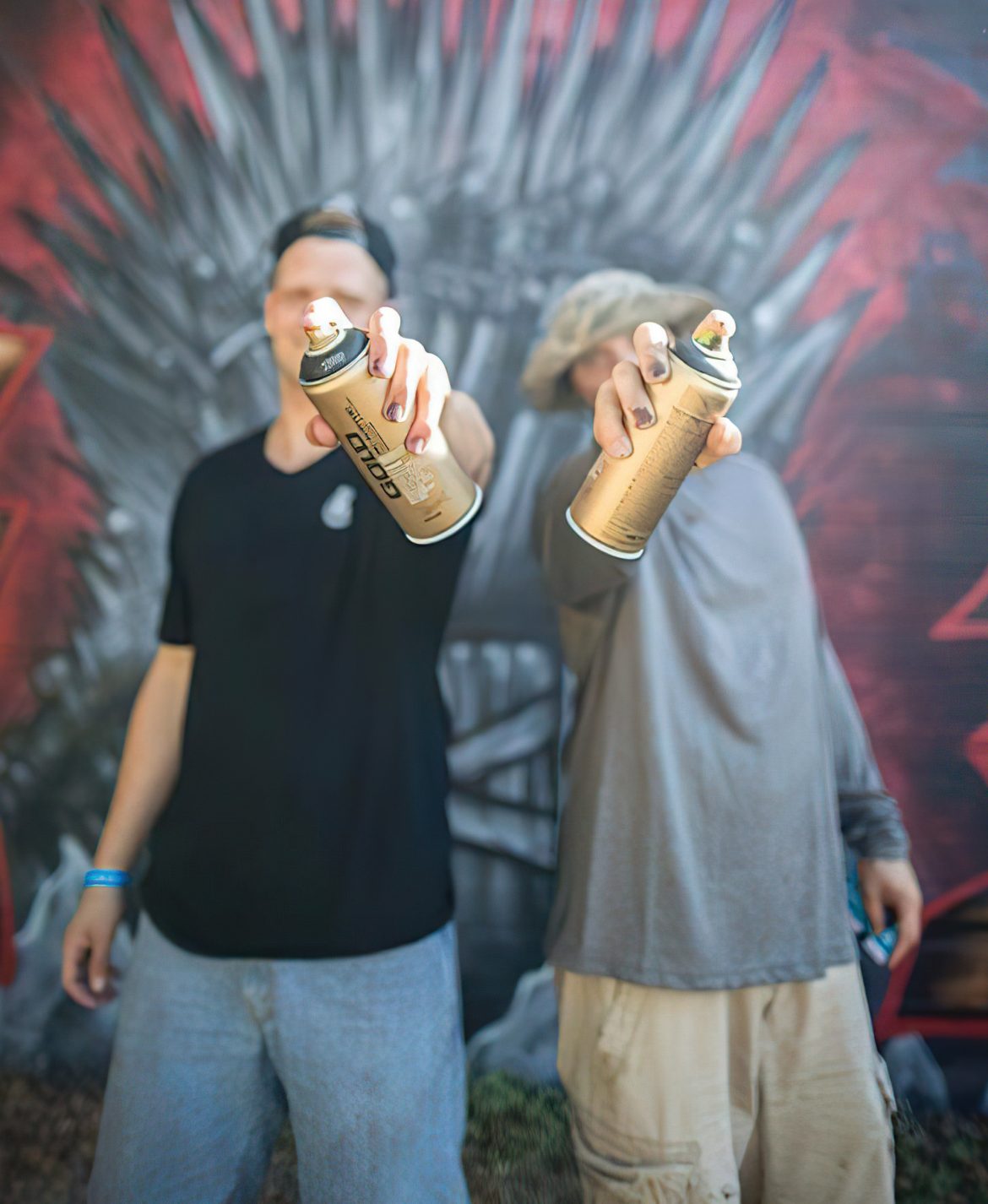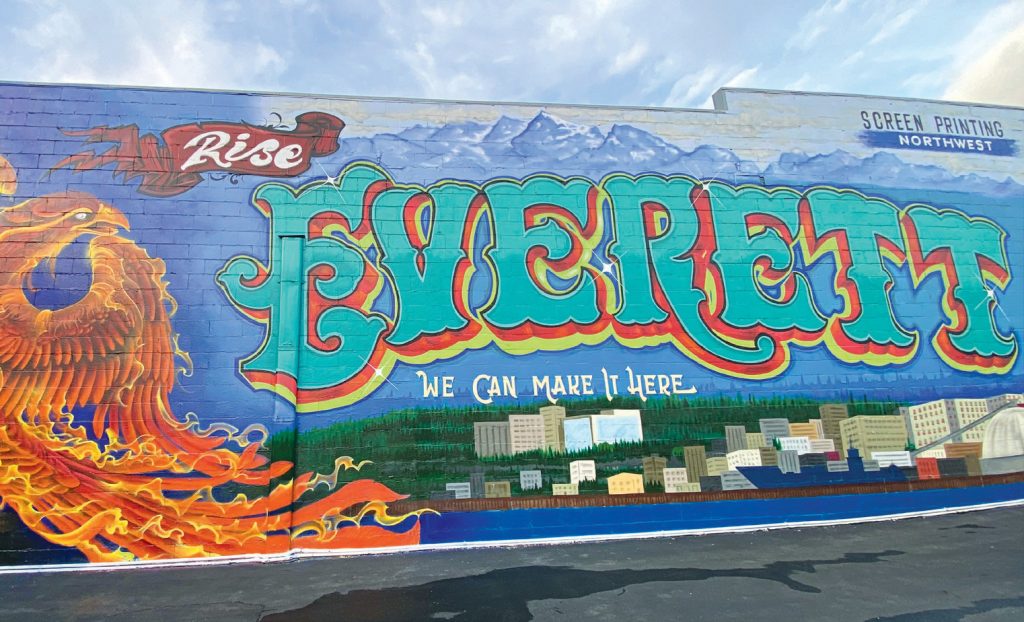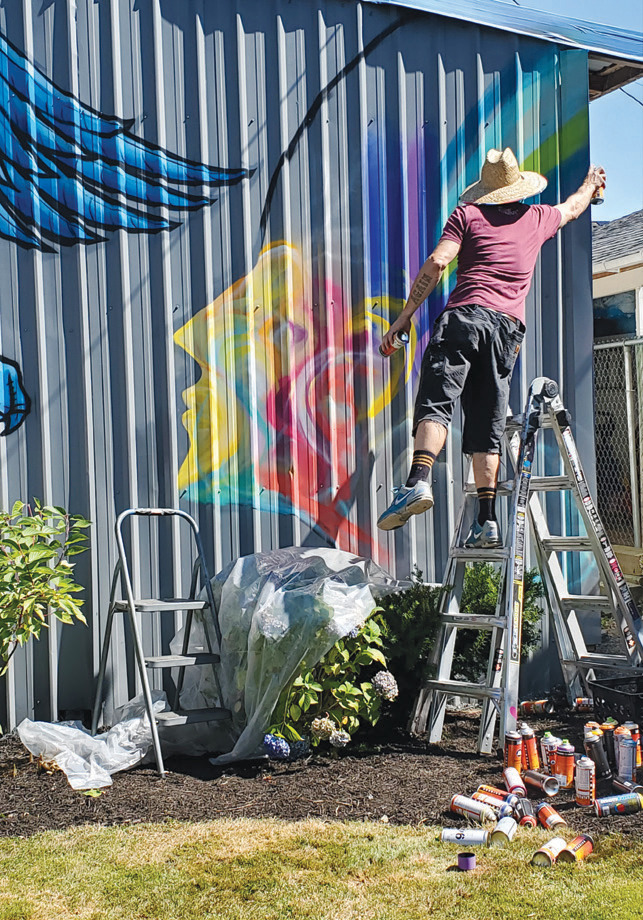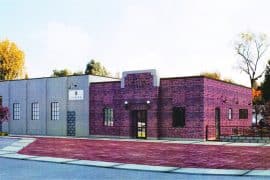Widely known graffiti artist Hyper puts his individual stamp on each new work
written by Ellen Hiatt
The paint can rattles and a swift movement across the cinder block wall sprays four gray, diffused lines of paint across what is to become the likeness of a building in the distance. Hyper and his crew worked through October rain, wet aerosol-delivered pigments dripping from the top of the building, to paint a stunning Phoenix, resplendent in burnt orange and fiery yellow hues. The message: “Rise Everett.”
“Half the days I don’t know how they were doing it,” said business owner Taylor Baehm. He is co-owner of Screenprinting NW, the business that sanctioned the mural. Baehm said the mural brought a lot of attention when it was first created last year.
“As soon as people started seeing the colors and the talent come to life …,” Baehm paused. “It’s captivating.”
The mural was one of 23 dreary building walls to get a makeover in an event Hyper created to bring some artistic life to the city. The murals were free if the building owner granted artistic freedom. Once a gritty mill town, Everett is re-making itself with a revitalized, urban waterfront and a budding, edgy arts scene.
“There’s negative you could find in any city. But the opposite is building and growing, and the best is yet to come,” Bahem said. “Rise Everett,” indeed.
Hyper goes by his street graffiti name alone—it’s part of the culture of graffiti, a genre of art that has its roots in the hip hop scene, its genesis the antithesis of the disco-fueled parties of the ’60s and ’70s, all glitter and big shoes and bell bottoms. The “OGs” of that era—the Older Generation—were the disenfranchised youth, holding parties in abandoned buildings in New York, break dancing and deejaying. The visual artists among them adopted the least expensive art tool on the market (a can of automotive spray paint) and the least expensive canvas (the walls of the subway system and abandoned buildings).
The four key elements of hip hop have all had their day of recognition: deejaying, MCing, and break dancing are well recognized forms of art. But graffiti, with its inherent canvas of stolen city walls has all along been seen as “the devil’s work,” said Hyper.
“A lot of people still see it as vandalism. There’s a side of it that is vandalism,” Hyper acknowledges. “That is just the exposure side of it trying to be heard, trying to be All City. Many youth see it as a voice, as their art form, with no rules or boundaries. It’s their way of being heard.”
Going All City means anywhere in a city your graffiti tag can be seen. “It’s basically the roots of it. It’s where you learn to get your style and where your style starts. It’s unfortunate that’s where a lot of it has to start. It’s hard to explain. It’s still a part of a culture.”
City buildings bear witness to the evolution of an artist. “The way they shape and form their letters is how an artist evolves and gets his own style. That’s the nice thing about graffiti. I personally change up constantly, trying to evolve with any art form. Graffiti has started to evolve at a high level.”
You can see that evolution in his fine art, as well, which often includes calligraffiti.
Hyper’s wife, Brianna (also following graffiti culture to not use her last name here) said that calligraffiti takes inspiration from hieroglyphs, Middle Eastern and Asian languages. Sometimes the writing contains a message only the artist can recognize, she said. “Much like many graffiti styles.”
“There’s still an aspect of graffiti gangs marking their territory,” Hyper said. “Most of the time they still adhere to a set of rules. Certain things go over certain things, go over certain things.”
That code of conduct, the culture of graffiti, can be a flash point. Los Angeles graffiti artist, Hans, remembered crewing with Hyper in a graffiti festival in Saint Louis when the promoter asked Graffaholeks, Hyper’s crew, to paint over a young crew’s work on a sea container. Hans, this generation’s OG, diffused the tension unwittingly created by offering up cans of paint, the starving artists’ precious commodity.
“These are younger dudes from that area. They probably have to buy their paint or steal it. It’s a commodity. We don’t waste our paints. That was a tense moment. Hyper totally diffused it. He totally smoothed it out and made it cool,” Hans said.
The OG in Hyper also helps new artists find their stride. “He’s an activator. He puts people in place and activates them. Leads by example and does more than his share of the work. He helps people expand,” Hans said.
“Hyper has the graffiti community behind him. A lot of people he knows from all around the nation, not just in town. He’s incredibly motivated,” said fellow graffiti artist, Spaz. “He’s one of the best graffiti artists out there.”










Comments are closed.